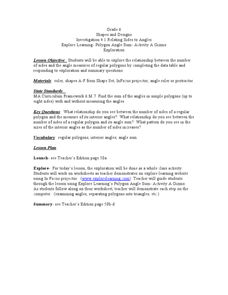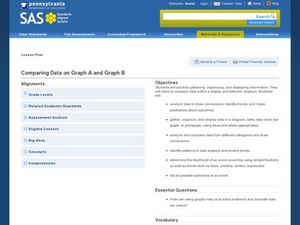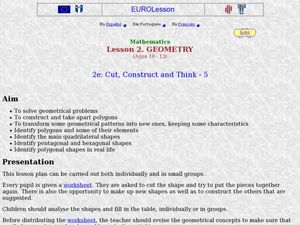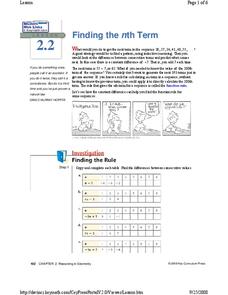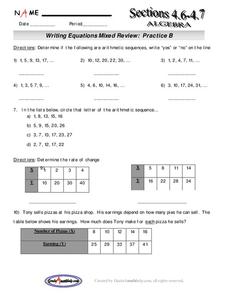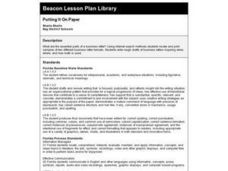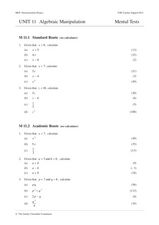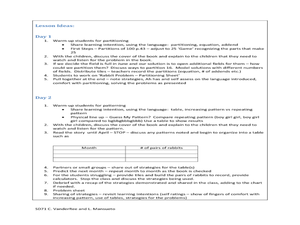Curated OER
What Is the Rule?
In this what is the rule worksheet, students determine the rule/pattern to complete a table. In this fill in the blank worksheet, students subtract nine problems.
Curated OER
Shapes and Designs
In this shapes and designs worksheet, 10th graders solve and complete 6 different types of problems. First, they fill in the first two columns of the table show with their shapes. Then, students measure the interior angles of each...
Curated OER
Investigation - Dressing the Baby
Second graders complete an inquiry activity to determine how many combinations they can make using cut-outs of tops and bottoms. In this combinations and organized lists table, 2nd graders work with three colored cut-outs of tops and...
Curated OER
Divide Decimals by Decimals
In this dividing decimals worksheet, students review and observe examples, continue patterns, and multiply the dividend and divisor in each step by ten, so that the quotients remain the same. Students solve three problems.
Curated OER
Is the Hudson River Too Salty to Drink?
Students explore reasons for varied salinity in bodies of water. In this geographical inquiry lesson, students use a variety of visual and written information including maps, data tables, and graphs, to form a hypothesis as to why the...
Curated OER
2.0 "Water Is Life" Global Water Awareness Mini-Unit (Grades3-5)
Students study the amount of potable water on the Earth. In this water lesson, students examine the amount of potable water as compared to all the water on the Earth. They discuss why many parts of the world do not have access to good...
Curated OER
Himalayan Herds: Fractional Exponential Growth
Students solve problems by identifying exponential growth and decay and differentiating between patterns, relation and functions. In this algebra lesson, students apply concepts of exponential growth to solve problems.
Curated OER
Comparing Data on Graph A and Graph B
Second graders gather and graph data. In this graphing lesson, 2nd graders collect data and graph this information using tally charts, bar graphs, pictographs, or tables. They make predictions about the outcomes.
Curated OER
Guess My Rule: Diversity of Learners Adaptation
Students write equations if they change the data of the population to find patterns. They look for patterns in the data regarding male to female ratio (using the lowest possible). Students write a short story for the data that changes...
Curated OER
Systems of Linear Equations
Students use the calculator to represent a situation as a table, graph, and equation. They write systems of equations and find solutions to systems of equations. In addition, they explain and justify how they determined their
solutions...
Curated OER
Geometry: Cut, Construct, Think
Students identify the properties of polygons. In this geometry lesson, students cut out shapes try to construct polygons. Students analyze the shapes and fill out a table of characteristics.
Curated OER
Finding the nth Term
Students analyze patterns and try to figure out the next term in the sequence. In this algebra instructional activity, students discuss the functions rule and how it works to solve sequences. They practice solving problems and find the...
Curated OER
A Day to Remember!
Students study math. In this real-life problem solving lesson, students work on their skills dealing with time and money. They work in small groups on various time and money word problems and by the final day they have a final problem...
Curated OER
Writing Equations Mixed Review
Students write equations based on a pattern. In this algebra lesson, students calculate the arithmetic and geometric mean of a sequence. They rewrite word problems as a linear equation and solve real life scenario based on the given data.
Curated OER
How Tall is that Tree?
Students apply their math skills to develop an accurate estimate of the height of a tall tree. Three different methods are outlined. All grade levels should be able to perform the shadow method and the proportional method.
Mathematics TEKS Toolkit
Grade 6: Exploring c/d = pi
Introduce your math class to the perimeter of a circle. Teach them that pi describes the relationship between the circumference and the diameter. As a hands-on investigation, pairs or small groups use string to compare these two values...
Curated OER
Squares and Square Roots
Students find patterns relating the lengths of the sides of squares to their areas. In this squares and square roots lesson, students draw squares and find their areas. They estimate the sides of square when given the area. Students use...
Curated OER
Putting it On Paper
Learners locate and print samples of two different business letter formats. They write rough drafts of business letters inquiring when, where, and how math is used.
Curated OER
Algebraic Manipulation
In this algebraic manipulation worksheet, students examine a given number grid, find the pattern and determine an equation to fit the situation. They calculate the area of given rectangles. Students solve real life problems using given...
Curated OER
Circle Problem
In this geometry instructional activity, learners calculate what the maximum number of regions are that 8 chords can divide a circle. They follow a pattern to arrive at their answers. There is an answer key with this question.
NASA
Benford's Law
In this Benford's Law learning exercise, high schoolers read about the first digit frequency of numbers. Students solve 3 problems about sunspot numbers, solar wind magnetism and the depth of the latest earthquakes by using on line sites...
Curated OER
Exploring Exponential Models
Explore the difference between exponential growth and decay with this worksheet. Use tables, graphs, and algebraic methods to gain insight. The notion of an asymptote is also introduced.
Curated OER
Food Pyramid Power: Looking Back and Moving Forward
Students show their knowledge of properties of objects as it pertains to sorting and creating patterns. In this food pyramid power lesson, students show their ability to use whole numbers in different representations by appling...
Curated OER
The Rabbit Problem
Students notice a number pattern in the book The Rabbit Problem by Emily Gravett. In this number pattern lesson, students represent and describe numbers appropriate to their grade level.

